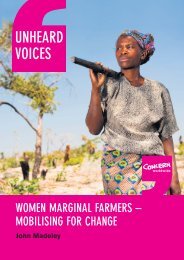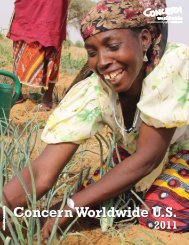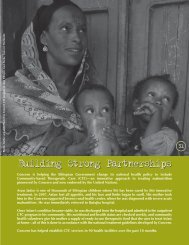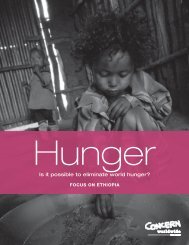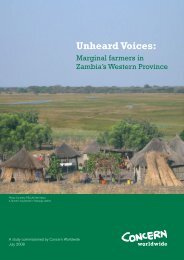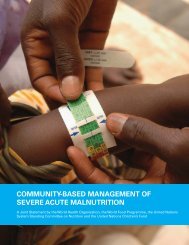the time is now: improving food security and nutrition for the poorest
the time is now: improving food security and nutrition for the poorest
the time is now: improving food security and nutrition for the poorest
You also want an ePaper? Increase the reach of your titles
YUMPU automatically turns print PDFs into web optimized ePapers that Google loves.
THE TIME IS NOW:<br />
IMPROVING FOOD SECURITY AND<br />
NUTRITION FOR THE POOREST<br />
ZENEBA MUHIA WITH HER HUSBAND SAID MOHAMMED AND CHILDREN OUTSIDE THEIR HOME, BUILT FROM EUCALYPTUS TREES AND CORRUGATED IRON SHEETING. (CHILDREN,<br />
CLOCKWISE, FROM LEFT: AHAMED, 2, FATIMA, 11, MOHAMMED, 7, ABDU, 4 AND ALGANESH, 6.) PHOTO: CAROLINE IRBY FOR CONCERN WORLDWIDE, SOUTH WOLLO, ETHIOPIA.
INTRODUCTION FROM THE<br />
CHIEF EXECUTIVE<br />
Since our founding in 1968 in response to <strong>the</strong> famine in Biafra,<br />
Nigeria, Concern Worldwide has pursued its m<strong>is</strong>sion to help people<br />
living in absolute poverty achieve major, sustainable improvements<br />
in <strong>the</strong>ir lives. Now, 43 years later, in 25 countries, Concern remains<br />
steadfastly committed to working with <strong>the</strong> world’s <strong>poorest</strong> people to<br />
trans<strong>for</strong>m <strong>the</strong>ir lives. Hunger <strong>is</strong> often <strong>the</strong> most v<strong>is</strong>ible manifestation<br />
of extreme poverty, <strong>and</strong> in <strong>the</strong> midst of increasingly volatile <strong>food</strong><br />
price increases <strong>and</strong> natural d<strong>is</strong>asters, Concern <strong>is</strong> more determined<br />
than ever be<strong>for</strong>e to empower <strong>the</strong> <strong>poorest</strong> to effectively produce <strong>and</strong><br />
manage <strong>the</strong>ir own <strong>food</strong> supplies, <strong>and</strong> to eradicate mal<strong>nutrition</strong> <strong>and</strong><br />
child hunger <strong>and</strong> <strong>the</strong>ir root causes.<br />
In all <strong>the</strong> places in which Concern works, we are<br />
continually confronted by <strong>the</strong> scourge of under<strong>nutrition</strong>.<br />
Lives are cut wretchedly short, <strong>the</strong> potential of millions of<br />
children <strong>is</strong> blighted, <strong>and</strong> <strong>the</strong> productivity <strong>and</strong> prosperity of<br />
nations are undermined. The loss <strong>and</strong> suffering caused<br />
by hunger are utterly unacceptable in our <strong>time</strong>, especially<br />
because we k<strong>now</strong> that solutions ex<strong>is</strong>t.<br />
The stat<strong>is</strong>tics are sobering. Over 35 percent of <strong>the</strong><br />
preventable deaths among children under five every year<br />
are associated with under<strong>nutrition</strong>. Lack of adequate<br />
<strong>nutrition</strong> causes irreversible physical <strong>and</strong> mental stunting<br />
in an estimated 195 million children per year. About 55<br />
million children suffer from wasting (acute mal<strong>nutrition</strong>),<br />
with low weight <strong>for</strong> <strong>the</strong>ir height: th<strong>is</strong> <strong>is</strong> equal to <strong>the</strong> total<br />
population of children under five living in industrialized<br />
countries. Under<strong>nutrition</strong> <strong>is</strong> also a concentrated problem,<br />
<strong>and</strong> one inextricably linked with poverty: over 90% of<br />
undernour<strong>is</strong>hed children live in just 36 countries.<br />
The very nature of hunger dem<strong>and</strong>s an urgent response.<br />
Adequate <strong>nutrition</strong> <strong>is</strong> critically important during <strong>the</strong> 1,000<br />
days from pregnancy to two years of age. There <strong>is</strong> <strong>now</strong><br />
conclusive evidence of <strong>the</strong> impact of under<strong>nutrition</strong><br />
on infant <strong>and</strong> child mortality <strong>and</strong> its largely irreversible<br />
long-term effects on health <strong>and</strong> cognitive <strong>and</strong> physical<br />
development. Ensuring adequate <strong>nutrition</strong> in <strong>the</strong> first<br />
years of life <strong>is</strong> essential to <strong>improving</strong> health outcomes.<br />
We k<strong>now</strong> when to act. We also k<strong>now</strong> that cost-effective<br />
<strong>and</strong> high-impact interventions ex<strong>is</strong>t. With th<strong>is</strong> k<strong>now</strong>ledge<br />
comes a responsibility to act.<br />
multilaterals <strong>and</strong> <strong>the</strong> private sector to save <strong>the</strong> lives <strong>and</strong><br />
protect <strong>the</strong> futures of <strong>the</strong> most marginalized <strong>and</strong> vulnerable<br />
children as we do today. While th<strong>is</strong> <strong>is</strong> vital to affecting<br />
change, political commitments must be accompanied by<br />
policy change backed up by additional resources.<br />
There are challenges ahead, but <strong>the</strong>y are not insurmountable<br />
if <strong>the</strong>re <strong>is</strong> political commitment <strong>and</strong> <strong>the</strong> will to work toge<strong>the</strong>r<br />
to address both <strong>the</strong> effects <strong>and</strong> <strong>the</strong> root causes of hunger.<br />
Concern’s work <strong>is</strong> <strong>the</strong> result of systemic, global v<strong>is</strong>ion,<br />
but its results are best viewed from <strong>the</strong> ground in <strong>the</strong><br />
real stories of partners coming toge<strong>the</strong>r to improve <strong>food</strong><br />
<strong>security</strong> <strong>and</strong> scale up <strong>nutrition</strong>. Th<strong>is</strong> booklet offers a brief<br />
“on-<strong>the</strong>-ground” view of Concern’s contribution to <strong>food</strong><br />
<strong>security</strong> <strong>and</strong> <strong>nutrition</strong> <strong>and</strong> of our commitment to innovation<br />
<strong>and</strong> partnership in <strong>the</strong> fight against hunger. Examples<br />
include our partnership with <strong>the</strong> International Food Policy<br />
Research Institute (IFPRI) on a project in Zambia to<br />
Realign Agriculture to Improve Nutrition (RAIN); Concern’s<br />
leadership in <strong>the</strong> development of <strong>the</strong> Community-<br />
Based Management of Acute Mal<strong>nutrition</strong> (CMAM),<br />
a decentralized approach with <strong>the</strong> potential to save<br />
millions of children’s lives; Concern’s work in conservation<br />
agriculture; our innovative, integrated, early response<br />
to a massive <strong>food</strong> cr<strong>is</strong><strong>is</strong> in Niger; our groundbreaking<br />
Innovations <strong>for</strong> Maternal, Newborn <strong>and</strong> Child Health<br />
initiative <strong>and</strong> our national <strong>and</strong> global advocacy ef<strong>for</strong>ts<br />
to scale up <strong>nutrition</strong>. We believe that we have reached<br />
a turning point in <strong>the</strong> fight to end child hunger, <strong>and</strong> we<br />
are proud to share stories of our ongoing <strong>and</strong> renewed<br />
ef<strong>for</strong>ts to promote <strong>the</strong> health of <strong>the</strong> <strong>poorest</strong> people in<br />
our world.<br />
Th<strong>is</strong> evidence has underpinned a number of recent political<br />
<strong>and</strong> policy initiatives aimed at <strong>improving</strong> early childhood<br />
<strong>nutrition</strong>. Never be<strong>for</strong>e have we had as much k<strong>now</strong>ledge,<br />
evidence, <strong>and</strong> political will combined with grassroots<br />
mobilization <strong>and</strong> collaboration between civil society, donors,<br />
2
ENDING CHILD HUNGER: A TURNING<br />
POINT FOR GLOBAL ACTION<br />
In 2008, <strong>the</strong> Brit<strong>is</strong>h medical journal <strong>the</strong> Lancet <strong>is</strong>sued a five-part series<br />
on <strong>nutrition</strong> that provided evidence on <strong>the</strong> impact of early childhood<br />
under<strong>nutrition</strong>. The most common <strong>for</strong>m of mal<strong>nutrition</strong> across <strong>the</strong> world <strong>is</strong><br />
micronutrient deficiency, which affects 2 billion people. The most widespread<br />
deficiencies highlighted were in vitamin A, zinc, iodine <strong>and</strong> iron.<br />
THE EVIDENCE<br />
While illness can cause mal<strong>nutrition</strong>, malnour<strong>is</strong>hed<br />
children are more at r<strong>is</strong>k of contracting illnesses such as<br />
diarrhea, malaria <strong>and</strong> pneumonia. Their growth <strong>is</strong> more<br />
likely to be stunted. Malnour<strong>is</strong>hed girls are more likely to<br />
give birth to low birth-weight offspring, contributing to a<br />
multi-generational cycle of mal<strong>nutrition</strong>. Impaired cognitive<br />
function leads to lower educational per<strong>for</strong>mance <strong>and</strong><br />
economic productivity, which means that child under<strong>nutrition</strong><br />
hinders economic development. Where childhood<br />
mal<strong>nutrition</strong> <strong>is</strong> pervasive, <strong>the</strong> loss to GDP can be as high as<br />
2 to 3 percent, not including <strong>the</strong> indirect costs of mal<strong>nutrition</strong><br />
such as healthcare <strong>and</strong> lost wages due to illness.<br />
The barriers children, young women <strong>and</strong> mo<strong>the</strong>rs face<br />
in meeting <strong>the</strong>ir <strong>nutrition</strong> needs include poverty, lack of<br />
education on healthy diets <strong>and</strong> infant care, lack of access<br />
to a diverse variety of nutritious <strong>food</strong>s, lack of access to<br />
adequate health care <strong>and</strong> sanitation, restrictive cultural<br />
practices, <strong>and</strong> low social status.<br />
In most countries of Sub-Saharan Africa, over 20 percent<br />
of women have a low body mass index <strong>and</strong> about 11 percent<br />
of children in <strong>the</strong> developing world are born small. In<br />
countries where gender inequality <strong>is</strong> great, high rates of<br />
hunger also occur because female members of a household<br />
will “eat least <strong>and</strong> eat last.”<br />
Low rates of exclusive breastfeeding (in developing<br />
countries th<strong>is</strong> rate <strong>is</strong> less than 50 percent) also inhibits<br />
a child’s growth <strong>and</strong> development <strong>and</strong> “suboptimal”<br />
breastfeeding results in <strong>the</strong> death of 1.4 million young<br />
children each year. Complementary <strong>food</strong>s, ideally<br />
introduced at 6 months, may also be unavailable,<br />
of poor <strong>nutrition</strong>al quality, or are introduced too early<br />
or too late.<br />
But <strong>the</strong> <strong>is</strong>sue of under<strong>nutrition</strong> does not end <strong>the</strong>re.<br />
The Lancet also identified proven <strong>and</strong> cost-effective<br />
interventions focused on <strong>the</strong> “window of opportunity”<br />
from minus 9 months to two years of age.<br />
Ca<strong>the</strong>rine Msigwa, Tanzania. Photographer: Mike Goldwater, 2008<br />
3
The steps that need to be taken are well understood.<br />
They include:<br />
■ a number of direct <strong>nutrition</strong>-specific interventions<br />
focusing on pregnant women <strong>and</strong> children under <strong>the</strong><br />
age of two<br />
■ broader multi-sectoral approaches such as supporting<br />
agricultural development, <strong>improving</strong> social protection<br />
<strong>and</strong> ensuring access to healthcare<br />
Building on <strong>the</strong> Lancet series, a World Bank study in<br />
2009 identified a package of 13 such interventions<br />
<strong>for</strong> <strong>the</strong> 1000 days between pregnancy <strong>and</strong> age 2.<br />
They would be delivered as part of wider public health<br />
programmes or, in <strong>the</strong> case of <strong>for</strong>tified <strong>food</strong>s, through<br />
private markets. They are summar<strong>is</strong>ed in Table 1.<br />
TABLE 1: EVIDENCE-BASED DIRECT INTERVENTIONS<br />
TO PREVENT AND TREAT UNDERNUTRITION<br />
PROMOTING GOOD NUTRITIONAL PRACTICES ($2.9 BILLION)<br />
■ Breastfeeding<br />
■ Complementary feeding <strong>for</strong> infants after <strong>the</strong> age of six months<br />
■ Improved hygiene practices, including h<strong>and</strong>-washing<br />
INCREASING INTAKE OF VITAMINS AND MINERALS ($1.5 BILLION)<br />
Prov<strong>is</strong>ion of micronutrients <strong>for</strong> young children <strong>and</strong> <strong>the</strong>ir mo<strong>the</strong>rs<br />
■ Periodic Vitamin A supplements<br />
■ Therapeutic zinc supplements <strong>for</strong> diarrhea management<br />
■ Multiple micronutrient powders<br />
■ De-worming drugs <strong>for</strong> children (to reduce losses of nutrients)<br />
■ Iron-folic acid supplements <strong>for</strong> pregnant women to prevent <strong>and</strong> treat anemia<br />
■ Iodized oil capsules where iodized salt <strong>is</strong> unavailable<br />
Prov<strong>is</strong>ion of micronutrients through <strong>food</strong> <strong>for</strong>tification <strong>for</strong> all<br />
■ Salt iodization<br />
■ Iron <strong>for</strong>tification of staple <strong>food</strong>s<br />
THERAPEUTIC FEEDING FOR MALNOURISHED CHILDREN WITH<br />
SPECIAL FOODS ($6.2 BILLION)<br />
■ Prevention or treatment <strong>for</strong> moderate under<strong>nutrition</strong><br />
■ Treatment of severe under<strong>nutrition</strong> (“severe acute mal<strong>nutrition</strong>”) with<br />
ready-to-use <strong>the</strong>rapeutic <strong>food</strong>s (RUTF).<br />
Source: Scaling up Nutrition: What will it cost Horton et al, 2009.<br />
Th<strong>is</strong> study estimated <strong>the</strong> total costs of <strong>the</strong> 13 interventions<br />
in <strong>the</strong> 36 highest burden countries at $11.8 billion<br />
annually <strong>and</strong> that <strong>the</strong>se interventions would save <strong>the</strong> lives<br />
of 1 million children annually.<br />
The benefits of investing in early childhood <strong>nutrition</strong><br />
have been highlighted by <strong>the</strong> Copenhagen Consensus<br />
Panel, a panel of leading econom<strong>is</strong>ts, who ranked <strong>the</strong><br />
prov<strong>is</strong>ion of micronutrients as <strong>the</strong> world’s best investment<br />
<strong>for</strong> development. Vitamin A <strong>and</strong> zinc supplementation <strong>for</strong><br />
children came in top yielding benefits worth $1 billion per<br />
year <strong>for</strong> an annual investment of $60 million.<br />
FROM FARM TO FORK<br />
In parallel with direct health interventions, global<br />
investments in agriculture <strong>and</strong> <strong>food</strong> <strong>security</strong> present a real<br />
opportunity to address maternal <strong>and</strong> child under<strong>nutrition</strong>.<br />
The price <strong>the</strong> international community pays <strong>for</strong> not<br />
tackling under<strong>nutrition</strong> <strong>is</strong> significant, <strong>and</strong> as such, th<strong>is</strong><br />
opportunity should be seized. Nutrition <strong>security</strong> depends<br />
on <strong>food</strong> <strong>security</strong> which, in turn, depends on sustainable<br />
agricultural development.<br />
In February 2011, over 1,000 stakeholders from <strong>the</strong><br />
<strong>nutrition</strong>, agriculture <strong>and</strong> health sectors, including<br />
Concern Worldwide, ga<strong>the</strong>red in New Delhi, India to focus<br />
on ways of leveraging agriculture <strong>for</strong> <strong>improving</strong> <strong>nutrition</strong><br />
<strong>and</strong> health. Protection of natural resources endangered<br />
by climate change, adequate support <strong>for</strong> small holder<br />
farmers, <strong>and</strong> addressing micronutrient deficiency<br />
will require integrated responses, developed at <strong>the</strong><br />
intersection of <strong>the</strong>se three key sectors. The k<strong>now</strong>ledge<br />
gap on how agriculture can most effectively contribute<br />
to <strong>nutrition</strong> <strong>and</strong> health outcomes needs to be filled, <strong>and</strong><br />
a commitment must be made to seek out <strong>and</strong> scale up<br />
innovative solutions.<br />
Better <strong>nutrition</strong> also requires improved access to markets,<br />
<strong>for</strong> example, through community associations <strong>and</strong> publicprivate<br />
partnerships.<br />
More than 60 percent of farmers in Africa are women.<br />
Empowering women in <strong>the</strong>ir roles as caregivers <strong>and</strong><br />
farmers will improve development. In recent years,<br />
women working in <strong>the</strong> agriculture, <strong>for</strong>estry <strong>and</strong> f<strong>is</strong>heries<br />
sectors have received only 7 to 9 percent of agricultural<br />
development ass<strong>is</strong>tance. Th<strong>is</strong> needs to be addressed if<br />
progress <strong>is</strong> to be real<strong>is</strong>ed.<br />
THE SCALING UP NUTRITION<br />
(SUN) FRAMEWORK<br />
Spurred by <strong>the</strong> groundbreaking evidence in <strong>the</strong> Lancet,<br />
as well as <strong>the</strong> <strong>food</strong> price cr<strong>is</strong><strong>is</strong> of 2008 that placed <strong>food</strong><br />
<strong>security</strong> <strong>and</strong> <strong>nutrition</strong> once again high on <strong>the</strong> political<br />
agenda, a global multi-stakeholder ef<strong>for</strong>t led to <strong>the</strong><br />
development of a Scaling Up Nutrition (SUN) Framework<br />
<strong>for</strong> Action <strong>and</strong> subsequent Roadmap. The SUN Framework<br />
was agreed in early 2010 <strong>and</strong> launched in April. It serves<br />
as a guide <strong>for</strong> <strong>the</strong> international community in ef<strong>for</strong>ts to<br />
combat under<strong>nutrition</strong> <strong>and</strong> has been endorsed by over<br />
100 partners from governments, civil society, international<br />
organ<strong>is</strong>ations, <strong>the</strong> private sector, <strong>and</strong> academia.<br />
Central to <strong>the</strong> SUN Framework <strong>is</strong> <strong>the</strong> recognition that<br />
<strong>the</strong> real work will take place, <strong>and</strong> needs to take place,<br />
at <strong>the</strong> country level. The Transition Team chaired by<br />
<strong>the</strong> UN Secretary General’s Special Representative <strong>for</strong><br />
Food Security <strong>and</strong> Nutrition, Dr. David Nabarro, <strong>and</strong> task<br />
<strong>for</strong>ces will offer support <strong>and</strong> guidance to national level<br />
processes <strong>and</strong> plans. Representatives from developing<br />
countries are also part of <strong>the</strong> process <strong>and</strong> structure at<br />
global level.<br />
4
The SUN Framework was rapidly followed by <strong>the</strong><br />
development of “A Road Map <strong>for</strong> Scaling Up Nutrition,”<br />
which was launched at <strong>the</strong> UN General Assembly Summit<br />
<strong>for</strong> <strong>the</strong> Millennium Development Goals in September 2010.<br />
The SUN Roadmap anticipates <strong>the</strong>re will be (a) mult<strong>is</strong>takeholder<br />
plat<strong>for</strong>ms within countries participating in <strong>the</strong><br />
ef<strong>for</strong>t to Scale Up Nutrition, <strong>and</strong> that <strong>the</strong>y will become<br />
increasingly important as a means to ensure joint ef<strong>for</strong>ts<br />
<strong>and</strong> a shared responsibility <strong>for</strong> results, (b) improved<br />
sharing of experiences between countries <strong>and</strong> regions,<br />
(c) joint action by different stakeholders to encourage<br />
advocacy, (d) a major ef<strong>for</strong>t to stimulate relevant research,<br />
(e) harmonized policy guidance, (g) better aligned ass<strong>is</strong>tance<br />
from development partners, (h) stronger governance <strong>and</strong><br />
coordination of intergovernmental action, (i) support <strong>for</strong><br />
individuals as <strong>the</strong>y become leaders <strong>for</strong> <strong>nutrition</strong> <strong>and</strong><br />
(j) a long-term commitment from national governments.<br />
Some heads of Governments or senior officials have<br />
already indicated <strong>the</strong>ir intention to participate in <strong>the</strong><br />
SUN movement to scale up <strong>nutrition</strong>, <strong>and</strong> to become<br />
“early r<strong>is</strong>er” countries. These include: Bangladesh,<br />
Ethiopia, Guatemala, Malawi, Mozambique, Nepal, Niger,<br />
Peru, Senegal, Tanzania, Ug<strong>and</strong>a, Mali, Rw<strong>and</strong>a, Sierra<br />
Leone, Ghana, Haiti, Zambia, <strong>and</strong> Benin.<br />
MOVING FORWARD<br />
The international <strong>nutrition</strong> community has accumulated<br />
extensive evidence on under<strong>nutrition</strong>. Countries <strong>and</strong> <strong>the</strong>ir<br />
partners have <strong>the</strong> k<strong>now</strong>ledge <strong>and</strong> experience concerning<br />
<strong>the</strong> management of multi-stakeholder plat<strong>for</strong>ms <strong>and</strong><br />
<strong>the</strong> capacities needed <strong>for</strong> scaling up <strong>nutrition</strong>. Global<br />
momentum <strong>is</strong> building <strong>for</strong> a renewed ef<strong>for</strong>t to translate<br />
<strong>the</strong>se assets into large-scale improvements in <strong>the</strong><br />
<strong>nutrition</strong> of high-burden countries.<br />
The coming years will be crucial <strong>for</strong> sustaining <strong>the</strong><br />
commitment, capacities <strong>and</strong> coordination <strong>for</strong> <strong>the</strong>se ef<strong>for</strong>ts<br />
to succeed. There are important roles in th<strong>is</strong> process <strong>for</strong> all<br />
stakeholders—national governments, donors, civil society,<br />
<strong>and</strong> <strong>the</strong> private sector. Joint ef<strong>for</strong>ts <strong>and</strong> intersectoral support<br />
towards a common goal will be paramount to achieving once<br />
<strong>and</strong> <strong>for</strong> all <strong>the</strong> eradication of hunger <strong>and</strong> under<strong>nutrition</strong>.<br />
Greenl<strong>and</strong><br />
2010 GLOBAL HUNGER INDEX SCORES BY SEVERITY<br />
Icel<strong>and</strong><br />
Sweden<br />
Norway<br />
Finl<strong>and</strong><br />
Russian Federation<br />
Estonia<br />
United Kingdom<br />
Denmark<br />
Latvia<br />
Lithuania<br />
Canada<br />
United States<br />
of America<br />
Mexico<br />
Western Sahara<br />
Irel<strong>and</strong><br />
Portugal<br />
Morocco<br />
Spain<br />
Neth.<br />
Bel.<br />
France<br />
Algeria<br />
Germany<br />
Lux. Czech Rep.<br />
Slovakia<br />
Austria<br />
Switz. Hungary<br />
Slov.<br />
Croatia<br />
Italy Bos. &<br />
HerzṢerb.<br />
Mont.<br />
Mace.<br />
Albania<br />
Greece<br />
Tun<strong>is</strong>ia<br />
Pol<strong>and</strong><br />
Libya<br />
Belarus<br />
Ukraine<br />
Mold.<br />
Romania<br />
Kazakhstan<br />
Bulgaria<br />
Georgia<br />
Uzbek<strong>is</strong>tan Kyrgyz Rep.<br />
Armenia Azerb.<br />
Turkey<br />
Turkmen<strong>is</strong>tan Tajik<strong>is</strong>tan<br />
Cyprus Syrian<br />
Lebanon<br />
Arab Rep.<br />
Iran,<br />
Afghan<strong>is</strong>tan<br />
Israel<br />
Iraq Islamic Rep.<br />
Jordan<br />
Kuwait<br />
Pak<strong>is</strong>tan<br />
Egypt,<br />
Bahrain<br />
Arab Rep.<br />
Qatar<br />
Saudi Arabia U.A.E.<br />
Nepal<br />
Bhutan<br />
Bangladesh<br />
Mongolia<br />
China<br />
N. Korea<br />
S. Korea<br />
Japan<br />
Cuba<br />
Dom. Rep.<br />
Belize Jamaica Haiti<br />
Honduras<br />
Guatemala<br />
Nicaragua<br />
El Salvador<br />
Panama<br />
Trinidad & Tobago<br />
Costa Rica<br />
Venezuela, RB Guyana<br />
French Guiana<br />
Suriname<br />
Colombia<br />
Ecuador<br />
Peru<br />
Senegal<br />
The Gambia<br />
Guinea-B<strong>is</strong>sau<br />
Guinea<br />
Sierra Leone<br />
Mauritania<br />
Liberia<br />
Mali<br />
Niger<br />
Burkina Faso<br />
Benin<br />
Nigeria<br />
Côte Togo<br />
d'Ivoire<br />
Central African<br />
Ghana<br />
Republic<br />
Cameroon<br />
Equatorial Guinea<br />
Congo,<br />
Gabon Rep.<br />
Chad<br />
Congo,<br />
Dem. Rep.<br />
Sudan<br />
Ug<strong>and</strong>a<br />
Rw.<br />
Bur.<br />
Kenya<br />
Tanzania<br />
Eritrea<br />
Ethiopia<br />
Yemen, Rep.<br />
Djibouti<br />
Somalia<br />
Oman<br />
India<br />
Sri Lanka<br />
Myanmar<br />
Lao<br />
PDR<br />
Thail<strong>and</strong><br />
Cambodia<br />
Vietnam<br />
Brunei<br />
Malaysia<br />
Philippines<br />
Indonesia<br />
Papua<br />
New Guinea<br />
Brazil<br />
Angola<br />
Zambia<br />
Malawi<br />
Comoros<br />
Timor-Leste<br />
Chile<br />
Bolivia<br />
Paraguay<br />
Namibia<br />
Zimbabwe Mozambique<br />
Botswana<br />
Swazil<strong>and</strong><br />
Madagascar<br />
Mauritius<br />
Australia<br />
Argentina<br />
Uruguay<br />
South<br />
Africa<br />
Lesotho<br />
> 30.0 Extremely alarming<br />
20.0–29.9 Alarming<br />
10.0–19.9 Serious<br />
5.0–9.9 Moderate<br />
< 4.9 Low<br />
No data<br />
Industrialized country<br />
Note: For <strong>the</strong> 2010 GHI, data on <strong>the</strong> proportion of undernour<strong>is</strong>hed are <strong>for</strong> 2004–06, data on<br />
child underweight are <strong>for</strong> <strong>the</strong> latest year in <strong>the</strong> period 2003–08 <strong>for</strong> which data are available,<br />
<strong>and</strong> data on child mortality are <strong>for</strong> 2008.<br />
MAP: GLOBAL HUNGER INDEX 2010, PRODUCED BY CONCERN WORLDWIDE, INTERNATIONAL FOOD POLICY RESEARCH INSTITUTE (IFPRI), AND WELTHUNGERHILFE<br />
HUNGER FACTS<br />
■ 925 million people do not have enough to eat <strong>and</strong> 98 percent of <strong>the</strong>m live in developing countries.<br />
■ Women make up a little over half of <strong>the</strong> world’s population, but <strong>the</strong>y account <strong>for</strong> over 60 percent of <strong>the</strong> world’s hungry.<br />
■ One out of four children in developing countries <strong>is</strong> underweight.<br />
5
Moses Kerokara, Emanual Tara <strong>and</strong> Mita Dav<strong>is</strong> from Gr<strong>and</strong> Bassa in Liberia. Mita <strong>is</strong><br />
one of <strong>the</strong> farmers benefiting from <strong>the</strong> services of <strong>the</strong> Concern supported ‘Farmers<br />
Resource Centre’. Photographer: Chr<strong>is</strong>topher Herwig, 2007<br />
CONCERN WORKS TO IMPROVE<br />
FOOD AND NUTRITION SECURITY<br />
Concern’s core m<strong>is</strong>sion <strong>is</strong> to make sustainable improvements in <strong>the</strong> lives of<br />
<strong>the</strong> extreme poor. Chief among <strong>the</strong>se improvements <strong>is</strong> <strong>the</strong> eradication of<br />
hunger <strong>and</strong> child under<strong>nutrition</strong>, which are both a cause <strong>and</strong> a consequence<br />
of poverty. The promotion of <strong>food</strong> <strong>and</strong> <strong>nutrition</strong> <strong>security</strong> has <strong>the</strong>re<strong>for</strong>e been<br />
central to Concern’s work since <strong>the</strong> organ<strong>is</strong>ation was founded in 1968. Our<br />
programmes work across multiple sectors in 25 countries to improve <strong>the</strong><br />
<strong>food</strong> production asset base <strong>and</strong> livelihood options of <strong>the</strong> extreme poor while<br />
reducing vulnerability to natural, social <strong>and</strong> economic shocks. Concern also<br />
responds to communities’ immediate needs in emergencies through <strong>the</strong><br />
direct prov<strong>is</strong>ion of a range of goods <strong>and</strong> services.<br />
Recogn<strong>is</strong>ing that increased availability <strong>and</strong> even<br />
increased access to <strong>food</strong> does not ensure sustained<br />
<strong>nutrition</strong> <strong>security</strong>, Concern also supports more direct<br />
<strong>nutrition</strong> interventions to ensure <strong>food</strong> <strong>is</strong> optimally util<strong>is</strong>ed<br />
<strong>and</strong> to support those who, in spite of <strong>food</strong> <strong>security</strong><br />
interventions, fall through <strong>the</strong> cracks <strong>and</strong> require<br />
treatment. Among <strong>the</strong>se direct interventions, Concern has<br />
particular expert<strong>is</strong>e in <strong>the</strong> community-based management<br />
of acute mal<strong>nutrition</strong> (CMAM), <strong>and</strong> also supports<br />
behavioural change communication to directly improve<br />
infant <strong>and</strong> young child feeding <strong>and</strong> health <strong>and</strong> hygiene<br />
practices. Finally, Concern supports programmes to<br />
improve access to quality health care services in<br />
12 countries <strong>and</strong> to quality water, sanitation <strong>and</strong> hygiene<br />
(WASH) facilities in 18 countries. These health <strong>and</strong><br />
WASH programmes work to both directly reduce child<br />
mortality due to d<strong>is</strong>ease <strong>and</strong> to indirectly reduce child<br />
under<strong>nutrition</strong>, of which d<strong>is</strong>ease <strong>is</strong> an underlying cause.<br />
6
Concern has been a global leader in <strong>the</strong> development of<br />
<strong>the</strong> community-based management of acute mal<strong>nutrition</strong><br />
(CMAM). Working in partnership with Valid International,<br />
Concern piloted th<strong>is</strong> new approach in three countries in<br />
2002/2003, at a <strong>time</strong> when treatment was limited to a<br />
grossly insufficient inpatient-only model. The innovative<br />
approach, which has proven successful at achieving high<br />
coverage, early detection <strong>and</strong> effective treatment of acute<br />
mal<strong>nutrition</strong> (wasting <strong>and</strong> <strong>nutrition</strong>al oedema), has <strong>now</strong><br />
been widely adopted as best practice by <strong>the</strong> UN <strong>and</strong> <strong>the</strong><br />
majority of governments <strong>and</strong> non-governmental agencies.<br />
Th<strong>is</strong> remarkable global shift to adopt <strong>the</strong> CMAM<br />
approach <strong>and</strong> <strong>the</strong> improvements in treatment access<br />
that have resulted are in large part due to <strong>the</strong> strategic<br />
partnership <strong>for</strong>ged between Concern <strong>and</strong> Valid <strong>and</strong> <strong>the</strong><br />
agencies’ joint commitment to community-led problem<br />
analys<strong>is</strong>; innovation; quality documentation, syn<strong>the</strong>s<strong>is</strong> <strong>and</strong><br />
d<strong>is</strong>semination of evidence; followed by ongoing technical<br />
support <strong>and</strong> advocacy <strong>for</strong> scale-up.<br />
Concern remains committed to <strong>the</strong> scale-up of quality<br />
CMAM <strong>and</strong> continues to directly <strong>and</strong> indirectly (through<br />
government partners) support CMAM in ten countries:<br />
Malawi, Ethiopia, Sudan (North <strong>and</strong> South), Kenya, Niger,<br />
Rw<strong>and</strong>a, Haiti, Ug<strong>and</strong>a, Nepal <strong>and</strong> Somalia <strong>and</strong> previously<br />
in Timor <strong>and</strong> DR Congo. Concern also continues to work<br />
at global <strong>and</strong> national level through <strong>the</strong> development<br />
of CMAM implementation guidelines, training modules,<br />
monitoring tools, <strong>and</strong> assessing <strong>the</strong> relative cost<br />
effectiveness of CMAM <strong>and</strong> conducting joint research<br />
with Valid on adapting CMAM <strong>for</strong> populations with high<br />
HIV prevalence <strong>and</strong> alternative, lower-cost recipes <strong>for</strong><br />
ready-to-use <strong>the</strong>rapeutic <strong>food</strong>s.<br />
Concern recogn<strong>is</strong>es that <strong>the</strong> impact of interventions<br />
on child <strong>nutrition</strong> can be improved, if <strong>the</strong>re <strong>is</strong> a better<br />
underst<strong>and</strong>ing of <strong>the</strong> factors which determine <strong>the</strong> extent<br />
of th<strong>is</strong> impact In order to contribute to <strong>the</strong> global evidence<br />
on th<strong>is</strong> link between <strong>food</strong> <strong>security</strong> interventions <strong>and</strong> child<br />
<strong>nutrition</strong> <strong>and</strong> to improve its own programmes, Concern<br />
has embarked on a new partnership with <strong>the</strong> International<br />
Food Policy <strong>and</strong> Research Institute (IFPRI), with funding<br />
from Ir<strong>is</strong>h Aid, to design an integrated agriculture-based<br />
programme that will prevent under<strong>nutrition</strong> <strong>and</strong> actually<br />
reduce <strong>the</strong> prevalence of stunting in children under<br />
five years.<br />
Scaling up evidence-based interventions <strong>is</strong> essential to<br />
achieving impact. Concern <strong>is</strong> currently working to identify<br />
barriers to scale up of key health interventions <strong>and</strong> develop<br />
innovative solutions to overcoming <strong>the</strong>m through its<br />
Innovations in Maternal, Newborn <strong>and</strong> Child Health Initiative.<br />
REALIGNING AGRICULTURE TO IMPROVE<br />
NUTRITION (RAIN)<br />
Concern <strong>and</strong> <strong>the</strong> International Food Policy Re-search Institute (IFPRI)<br />
have recently embarked on a partnership to design <strong>and</strong> rigorously<br />
evaluate a project to prevent stunting in young children by realigning<br />
a package of agriculture-based interventions to specifically improve<br />
<strong>nutrition</strong> components.<br />
The programme, currently being implemented in Mumbwa D<strong>is</strong>trict,<br />
Zambia <strong>is</strong> working to underst<strong>and</strong> <strong>and</strong> address <strong>the</strong> underlying causes<br />
of under<strong>nutrition</strong>. Like many traditional <strong>food</strong> <strong>security</strong> interventions, <strong>the</strong><br />
RAIN project aims to effectively improve <strong>food</strong> availability <strong>and</strong> access.<br />
One of <strong>the</strong> defining differences of <strong>the</strong> RAIN approach will be <strong>the</strong><br />
emphas<strong>is</strong> on underst<strong>and</strong>ing <strong>the</strong> key impact pathways linking agriculture<br />
<strong>and</strong> o<strong>the</strong>r interventions to improved <strong>nutrition</strong>al outcomes <strong>for</strong> children<br />
under two years of age <strong>and</strong> actually designing <strong>the</strong> core agricultural<br />
interventions to achieve those outcomes. In th<strong>is</strong> way, RAIN aims to go<br />
beyond <strong>the</strong> traditional objectives of <strong>food</strong> <strong>security</strong> programmes (e.g.<br />
increased yields, reported increase in meals per day) <strong>and</strong> to focus on<br />
measureable improvements in <strong>nutrition</strong> <strong>security</strong>.<br />
Saïd Mohammed on h<strong>is</strong> plot of l<strong>and</strong> at <strong>the</strong> Korichefe irrigation site,<br />
South Wollo zone, Ethiopia. Photographer: Caroline Irby, 2007<br />
Critical <strong>is</strong>sues such as <strong>the</strong> <strong>nutrition</strong>al profile of crops, methods of<br />
<strong>food</strong> storage <strong>and</strong> preservation, constraints <strong>and</strong> opportunities <strong>for</strong><br />
optimal infant <strong>and</strong> young child feeding, <strong>and</strong> <strong>the</strong> dec<strong>is</strong>ion making<br />
power <strong>and</strong> workload of women will be carefully considered during <strong>the</strong><br />
design phase. Essential components will be incorporated to address<br />
<strong>the</strong>se <strong>is</strong>sues, including promotion of nutritious crops/small livestock,<br />
women-focused appropriate technology, intensive behaviour change<br />
communication, links with health care <strong>and</strong> empowerment of women.<br />
7
CONSERVATION AGRICULTURE<br />
Concern has been promoting Conservation Agriculture in Zimbabwe since 2006,<br />
with impressive results. Concern has also introduced CA as part of an EU Food<br />
Facility project in Tanzania <strong>and</strong> has initiated a CA project in North Korea. In<br />
May 2010 Concern announced a major pilot project in Zambia <strong>and</strong> Malawi<br />
aimed at training 6,400 farmers in <strong>the</strong> techniques of Conservation Agriculture.<br />
Th<strong>is</strong> pilot project <strong>is</strong> being funded by an Accenture Global Giving Grant.<br />
WHAT IS CONSERVATION AGRICULTURE<br />
Almost three quarters of <strong>the</strong> l<strong>and</strong> in sub-Saharan Africa<br />
<strong>is</strong> partially or severely degraded. Th<strong>is</strong> has come about<br />
as a result of excessive soil d<strong>is</strong>turbance, <strong>the</strong> reduction<br />
in nutrients caused by monoculture, late planting <strong>and</strong><br />
<strong>the</strong> lack of investment in agriculture. The consequent<br />
reduction in yields <strong>is</strong> a major problem, most especially <strong>for</strong><br />
poor farmers, many of <strong>the</strong>m women, farming small plots<br />
of l<strong>and</strong>.<br />
Conservation agriculture has three key principles:<br />
do not d<strong>is</strong>turb <strong>the</strong> soil; keep <strong>the</strong> soil covered (using<br />
crop residues as mulch); <strong>and</strong> rotate <strong>the</strong> crops. In<br />
addition, Concern promotes <strong>the</strong> use of small amounts<br />
of carefully selected fertil<strong>is</strong>ers. Toge<strong>the</strong>r, <strong>the</strong>se simple<br />
techniques reduce <strong>the</strong> energy needed to farm, maintain<br />
<strong>the</strong> natural soil structure, help avoid excessive depletion<br />
of nutrients <strong>and</strong> maxim<strong>is</strong>e <strong>the</strong> benefits (while minim<strong>is</strong>ing<br />
<strong>the</strong> cost) of fertil<strong>is</strong>er.<br />
Conservation agriculture <strong>is</strong> a radically different way of<br />
producing crops which leads to higher yields <strong>and</strong> earlier<br />
harvests, even in dry years. It uses techniques that reduce<br />
both erosion <strong>and</strong> <strong>the</strong> energy <strong>and</strong> workload needed to<br />
plant crops, conserves soil mo<strong>is</strong>ture <strong>and</strong> enables farmers<br />
to plant as soon as <strong>the</strong> rains start. Th<strong>is</strong> approach typically<br />
improves yields of maize by 70% without fertil<strong>is</strong>er; it more<br />
than trebles yields when fertil<strong>is</strong>er <strong>is</strong> introduced.<br />
Conservation agriculture uses resources more efficiently<br />
<strong>and</strong> improves flexibility. In Zimbabwe we achieved our<br />
results using relatively simple appropriate technology<br />
such as planting pits or simple ox-drawn rippers—tools<br />
which have deep penetration but cause minimum<br />
d<strong>is</strong>turbance to <strong>the</strong> soil. These save both <strong>time</strong> <strong>and</strong> ef<strong>for</strong>t<br />
<strong>and</strong> help increase yields.<br />
Conservation Agriculture <strong>is</strong> not a “silver bullet”—it <strong>is</strong> not<br />
appropriate <strong>for</strong> some soil types <strong>and</strong> some plants. But<br />
it can <strong>and</strong> <strong>is</strong> making a difference to <strong>the</strong> livelihoods of<br />
very many <strong>food</strong> insecure people in sub Saharan Africa<br />
<strong>and</strong> beyond. Moreover, it <strong>is</strong> sustainable. Many current<br />
practices are not.<br />
Concern used <strong>the</strong> Household<br />
Economy approach to evaluate <strong>the</strong><br />
impact of Conservation Agriculture<br />
by comparing poor <strong>and</strong> very poor<br />
farmers who had adopted CA with<br />
farmers in <strong>the</strong> same wealth group<br />
who pract<strong>is</strong>e traditional agriculture<br />
Total Kg Produced Per Farmer<br />
1000<br />
800<br />
600<br />
400<br />
200<br />
CROP PRODUCTION (Gokwe North)<br />
0<br />
CA V. Poor<br />
V. Poor CA Poor Poor GKN<br />
millet cowpeas groundnuts sorghum maize<br />
8
Women in Gokwe, Zimbabwe present <strong>the</strong>ir reg<strong>is</strong>tration cards at a Concernmanaged<br />
cash d<strong>is</strong>tribution point. Photo: Elena Ruiz Roman, Zimbabwe<br />
EMERGENCY RESPONSE<br />
Concern works in some of <strong>the</strong> most <strong>poorest</strong> <strong>and</strong> vulnerable countries in <strong>the</strong><br />
world. All of our countries of operation are affected by d<strong>is</strong>asters—many of<br />
which are predictable <strong>and</strong> recurrent. Working with communities to mitigate <strong>the</strong><br />
r<strong>is</strong>k <strong>and</strong> impact of <strong>the</strong>se d<strong>is</strong>asters <strong>is</strong> an essential component of our work, <strong>and</strong><br />
in many locations we work to improve community resilience <strong>and</strong> to establ<strong>is</strong>h<br />
in<strong>for</strong>mation/early warning systems to help poor communities better prepare <strong>for</strong><br />
<strong>and</strong> mitigate against <strong>the</strong> impact of d<strong>is</strong>asters. Aware that mitigation measures<br />
cannot prevent all d<strong>is</strong>asters from occurring, we also pride ourselves on <strong>the</strong><br />
speed <strong>and</strong> appropriateness of our emergency responses.<br />
The purpose of our interventions <strong>is</strong> to address <strong>the</strong><br />
immediate needs of d<strong>is</strong>aster affected populations<br />
through enhancing <strong>the</strong>ir capacity to cope. Th<strong>is</strong> may<br />
compr<strong>is</strong>e <strong>the</strong> d<strong>is</strong>tribution of <strong>food</strong> <strong>and</strong> o<strong>the</strong>r essential<br />
life saving interventions—access to clean water, shelter,<br />
or <strong>the</strong> means of ass<strong>is</strong>ting in <strong>the</strong> rapid recovery of <strong>the</strong>ir<br />
productive capacity <strong>and</strong> assets.<br />
In 2010, Concern responded to 41 emergencies in<br />
14 countries. Eighteen of <strong>the</strong>se emergencies occurred<br />
in areas of conflict, some in conflict zones where<br />
Concern has been active <strong>for</strong> many years such as<br />
Somalia, South Sudan <strong>and</strong> Chad. The main responses<br />
occurred in three countries affected by massive<br />
cr<strong>is</strong>es—Haiti, Pak<strong>is</strong>tan <strong>and</strong> Niger (please see box<br />
on next page).<br />
In January 2010, a devastating earthquake hit Haiti, causing<br />
one of <strong>the</strong> largest natural d<strong>is</strong>asters in h<strong>is</strong>tory. More than<br />
220,000 were killed <strong>and</strong> millions were made homeless<br />
in <strong>the</strong> immediate aftermath of <strong>the</strong> earthquake. Concern<br />
responded by d<strong>is</strong>tributing NFIs (non-<strong>food</strong> items), providing<br />
water <strong>and</strong> sanitation facilities, managing camps, providing<br />
cash-<strong>for</strong>-work <strong>and</strong> cash transfers, <strong>and</strong> <strong>nutrition</strong> <strong>and</strong><br />
emergency education interventions. We also provided<br />
temporary shelter (e.g. tents) <strong>and</strong> have constructed transitional<br />
shelters <strong>for</strong> families. As Haiti began to move from emergency<br />
response to reconstruction, it was faced with ano<strong>the</strong>r d<strong>is</strong>aster<br />
as cholera began to spread towards <strong>the</strong> end of 2010, killing<br />
more than 4,000 people. We have increased our water <strong>and</strong><br />
sanitation programmes as a result, providing latrines, soap<br />
<strong>and</strong> clean water as well as carrying out hygiene promotion.<br />
Our response in Haiti has helped 130,000 people.<br />
9
NIGER<br />
Millet <strong>is</strong> <strong>the</strong> crop that keeps most people alive in Niger. But drought <strong>and</strong><br />
failed rains in 2010 led to massive crop failure of millet <strong>and</strong> o<strong>the</strong>r staples,<br />
leaving 60 percent of <strong>the</strong> country’s population facing hunger.<br />
Concern Worldwide began tracking <strong>the</strong> first signs of <strong>the</strong> <strong>food</strong> cr<strong>is</strong><strong>is</strong> in<br />
October 2009. We launched an innovative, integrated, early response to<br />
reach 280,000 of <strong>the</strong> most vulnerable be<strong>for</strong>e <strong>the</strong> <strong>food</strong> ran out— be<strong>for</strong>e large<br />
numbers of children became severely malnour<strong>is</strong>hed.<br />
Concern focused on mobilizing early to prevent <strong>and</strong> mitigate <strong>the</strong><br />
onset of severe mal<strong>nutrition</strong>. The multi-sector response in Tahoua, one<br />
of <strong>the</strong> country’s most <strong>food</strong> insecure regions, involved: d<strong>is</strong>tributing drought<br />
res<strong>is</strong>tant seeds <strong>and</strong> fertilizer; screening, referring, <strong>and</strong> rein<strong>for</strong>cing <strong>the</strong><br />
Min<strong>is</strong>try of Health’s capacity to provide <strong>nutrition</strong> support to pregnant women,<br />
breastfeeding mo<strong>the</strong>rs, <strong>and</strong> children under five; <strong>and</strong> an innovative initiative that<br />
started d<strong>is</strong>tributing emergency cash—be<strong>for</strong>e <strong>the</strong> cr<strong>is</strong><strong>is</strong>—to <strong>the</strong> most vulnerable<br />
women in 160 villages via mobile phones <strong>and</strong> manual cash transfers.<br />
Initial results show that Concern’s response in Niger successfully prevented<br />
<strong>and</strong> averted a <strong>nutrition</strong> emergency in its target communities:<br />
■ Concern <strong>nutrition</strong> surveys undertaken with <strong>the</strong> Department of Health<br />
show that “global acute mal<strong>nutrition</strong>” rates in Tahoua D<strong>is</strong>trict were at<br />
11.7 percent—below <strong>the</strong> emergency threshold of 15 percent.<br />
■ Eighty percent of villages that were rated as being at r<strong>is</strong>k of extreme <strong>food</strong><br />
shortages in December 2009 had above-average harvests in 2010.<br />
Concern <strong>is</strong> in <strong>the</strong> process of completing research in partnership with Tufts<br />
University to analyze <strong>the</strong> impact of its different types of interventions on<br />
<strong>nutrition</strong> status in Tahoua. To help improve <strong>the</strong> effectiveness of responses<br />
to <strong>food</strong> cr<strong>is</strong>es, Concern will share <strong>the</strong> results of th<strong>is</strong> research with <strong>the</strong><br />
Government of Niger <strong>and</strong> <strong>the</strong> wider humanitarian community to help find<br />
better, more cost-effective ways to prevent <strong>and</strong> fight hunger.<br />
Agaycha Awikguini, a 50-year-old widow receives her first emergency<br />
cash transfer from Concern. Photo: Niger, Concern Worldwide<br />
2010 also saw Pak<strong>is</strong>tan face one of its worst<br />
humanitarian d<strong>is</strong>asters as floods ravaged <strong>the</strong> country,<br />
which killed nearly 2,000 people but affected more<br />
than 20 million across four provinces. Concern launched<br />
its largest ever emergency response in <strong>the</strong> country,<br />
providing approximately one million people with<br />
emergency ass<strong>is</strong>tance including drinking water, latrines,<br />
shelter, non-<strong>food</strong> items, <strong>food</strong> packages, debr<strong>is</strong> removal<br />
kits, <strong>and</strong> emergency medical services. Concern in<br />
Pak<strong>is</strong>tan <strong>is</strong> responsible <strong>for</strong> overseeing <strong>the</strong> d<strong>is</strong>bursement<br />
of <strong>the</strong> US Office <strong>for</strong> Overseas D<strong>is</strong>aster Ass<strong>is</strong>tance<br />
(OFDA) funded ‘Responding to Pak<strong>is</strong>tan’s Internally<br />
D<strong>is</strong>placed’ (RAPID) grant to organizations providing<br />
humanitarian ass<strong>is</strong>tance in emergency situations<br />
in Pak<strong>is</strong>tan.<br />
Extreme wea<strong>the</strong>r <strong>is</strong> a major cause of emergencies,<br />
with Concern implementing 14 emergency programmes<br />
in response to climate related d<strong>is</strong>asters in 2010. We<br />
continued to work to mitigate <strong>the</strong> effects of drought in<br />
Ethiopia, Kenya <strong>and</strong> Niger, while flooding prompted us<br />
to respond in Afghan<strong>is</strong>tan, Ethiopia, India, Pak<strong>is</strong>tan,<br />
South Sudan <strong>and</strong> Tanzania.<br />
The nature of our interventions varies according to <strong>the</strong><br />
needs identified on <strong>the</strong> ground. In circumstances where<br />
<strong>food</strong> <strong>is</strong> available in <strong>the</strong> market but people are unable<br />
to access it because of lack of money, we may seek to<br />
inject cash into <strong>the</strong> local economy by transferring limited<br />
amounts of cash to <strong>the</strong> very <strong>poorest</strong>. Such cash transfer<br />
programmes are carried out by our teams in Niger,<br />
Zimbabwe, India, Kenya, Sierra Leone <strong>and</strong> Zambia. We<br />
are using mobile phone technology to transfer cash to<br />
poor people in Niger—<strong>and</strong> have done so in Kenya <strong>and</strong><br />
o<strong>the</strong>r countries. In Zimbabwe, Concern <strong>and</strong> WFP (World<br />
Food Programme) are co-operating in a pilot project<br />
intended to assess <strong>the</strong> relative effects of giving people<br />
cash, <strong>food</strong> or part cash <strong>and</strong> part <strong>food</strong> in order to deal<br />
with “<strong>the</strong> hunger season” in that country. An evaluation<br />
of <strong>the</strong> Zimbabwe project by Ox<strong>for</strong>d Policy Management<br />
in 2010 highlights that recipients of <strong>the</strong> transfers were<br />
able to obtain sufficient staple <strong>food</strong> <strong>for</strong> <strong>the</strong> duration<br />
of <strong>the</strong> project, <strong>and</strong> <strong>the</strong> transfer of cash, cash <strong>and</strong> <strong>food</strong>,<br />
<strong>and</strong> <strong>food</strong> were all found to have positive impacts on<br />
intra-household relations. Following <strong>the</strong> evaluation<br />
<strong>the</strong> composition of <strong>the</strong> transfers has been modified<br />
to a more cost-effective <strong>and</strong> locally appropriate<br />
combination of <strong>food</strong> <strong>and</strong> cash.<br />
Recogn<strong>is</strong>ing <strong>the</strong> need to <strong>for</strong>esee <strong>and</strong> better prepare<br />
<strong>for</strong> emergencies, Concern <strong>is</strong> moving to a process where<br />
r<strong>is</strong>k <strong>and</strong> vulnerability <strong>is</strong> better understood <strong>and</strong> longer<br />
term development programmes seek to mitigate against<br />
<strong>the</strong>se. Examples of D<strong>is</strong>aster R<strong>is</strong>k Reduction include<br />
Watershed Management (building bunds to trap water,<br />
building channels to divert excess water) <strong>and</strong> Natural<br />
Resource Management (e.g. rotation of pastures,<br />
corralling). Th<strong>is</strong> <strong>is</strong> an aspect of our work which will<br />
become ever more important as <strong>the</strong> effects of climate<br />
change make <strong>the</strong>mselves felt.<br />
10
Participants of Concern’s Municipal Health Partnership Program Kurigram, Bangladesh attending an in<strong>for</strong>mation session<br />
on d<strong>is</strong>advantaged mo<strong>the</strong>rs’ basic rights in accessing health care services. Photo: Allyson Brown, Concern Worldwide<br />
ADVOCACY<br />
Concern Worldwide <strong>is</strong> a “doing” organ<strong>is</strong>ation. For more than <strong>for</strong>ty years we have<br />
been active on <strong>the</strong> ground in dozens of countries helping poor people to cope<br />
with <strong>the</strong> effects of poverty, natural d<strong>is</strong>asters <strong>and</strong> conflict. Yet, we ack<strong>now</strong>ledge<br />
that th<strong>is</strong> work <strong>is</strong> not enough. We look to go fur<strong>the</strong>r in using <strong>the</strong> experience<br />
derived from our work to in<strong>for</strong>m <strong>and</strong> influence <strong>the</strong> people who make <strong>the</strong><br />
dec<strong>is</strong>ions <strong>and</strong> <strong>for</strong>mulate <strong>the</strong> policies which influence <strong>the</strong> lives of <strong>the</strong> poor.<br />
In <strong>the</strong> developing world itself our role <strong>is</strong> to support local<br />
partners in <strong>the</strong>ir interaction with dec<strong>is</strong>ions makers. Our<br />
role <strong>is</strong> to facilitate local people in having <strong>the</strong>ir voices heard.<br />
■ In Or<strong>is</strong>sa, India Concern works with partners, tackling<br />
corrupt practices <strong>and</strong> seeking to ensure that people<br />
receive <strong>the</strong>ir state entitlements.<br />
■ In Sierra Leone, Concern advocated <strong>for</strong> <strong>the</strong> introduction<br />
of free health care <strong>for</strong> pregnant women <strong>and</strong> young<br />
children. Th<strong>is</strong> has <strong>now</strong> been implemented by <strong>the</strong> Sierra<br />
Leone Government.<br />
■ In Bangladesh, Concern’s “We are People Too” campaign<br />
succeeded in persuading Dhaka City Corporation to<br />
extend its birth reg<strong>is</strong>tration to <strong>the</strong> thous<strong>and</strong>s of people<br />
who live in <strong>the</strong> City’s streets <strong>the</strong>reby giving pavement<br />
dwellers equal entitlement to services.<br />
particular women famers. Concern UK leads our work on<br />
th<strong>is</strong> <strong>is</strong>sue through <strong>the</strong> “Unheard Voices” Campaign.<br />
In Europe, <strong>the</strong> United States <strong>and</strong> globally we participate<br />
in key <strong>for</strong>ums, bringing our expert<strong>is</strong>e to bear to influence<br />
development <strong>and</strong> humanitarian policy at <strong>the</strong> highest<br />
levels, including <strong>the</strong> 1,000 Days Partnership.<br />
Concern <strong>is</strong> an active participant in <strong>the</strong> activities of<br />
Concord, Voice <strong>and</strong> ICVA, <strong>and</strong> also of Interaction in <strong>the</strong><br />
United States. Concern <strong>is</strong> also active in <strong>the</strong> Nutrition<br />
Action Group which compr<strong>is</strong>es a small number of NGO’s<br />
advocating in <strong>the</strong> area of Nutrition <strong>and</strong> Maternal Health<br />
<strong>and</strong> a member of <strong>the</strong> Contact Group which acted in an<br />
adv<strong>is</strong>ory role during <strong>the</strong> re<strong>for</strong>m process of <strong>the</strong> Committee<br />
on Food Security of <strong>the</strong> FAO.<br />
In Irel<strong>and</strong>, Concern has worked in concert with Ir<strong>is</strong>h Aid<br />
in sharing learning <strong>and</strong> experience. Concern’s CEO, Tom<br />
Arnold, served on <strong>the</strong> “Hunger Task Force” charged by<br />
<strong>the</strong> Ir<strong>is</strong>h Government with developing a national strategy<br />
to combat hunger in <strong>the</strong> Developing World. The need<br />
to combat hunger <strong>and</strong> its primary cause, poverty, <strong>is</strong> <strong>the</strong><br />
central focus Concern’s advocacy work.<br />
In that context Concern looks to direct attention to <strong>the</strong><br />
needs of marginal farmers (farming but hungry) <strong>and</strong> in<br />
Concern has a special focus on <strong>the</strong> effectiveness of aid.<br />
Concern <strong>is</strong> taking a lead role in <strong>the</strong> work of Alliance 2015<br />
in monitoring <strong>the</strong> per<strong>for</strong>mance of <strong>the</strong> European Union in<br />
looking to meet <strong>the</strong> Millennium Development Goals.<br />
Concern co-operates with Welthungerhilfe <strong>and</strong> IFPRI<br />
to produce <strong>the</strong> Global Hunger Index which analyses<br />
<strong>and</strong> calculates world hunger according to a number of<br />
different criteria. The 2009 Index focussed on gender<br />
inequality. The 2010 Index focuses on <strong>nutrition</strong>.<br />
11
concernworldwide.org<br />
ABOUT CONCERN WORLDWIDE<br />
Concern Worldwide <strong>is</strong> a non-governmental, international, humanitarian organization dedicated to <strong>the</strong><br />
reduction of suffering <strong>and</strong> working towards <strong>the</strong> ultimate elimination of extreme poverty in <strong>the</strong> world’s<br />
<strong>poorest</strong> countries.<br />
Concern’s m<strong>is</strong>sion <strong>is</strong> to help people living in absolute poverty achieve major improvements in <strong>the</strong>ir lives<br />
that last <strong>and</strong> spread without ongoing support from Concern Worldwide.<br />
Republic of Irel<strong>and</strong><br />
52-55 Lower Camden Street<br />
Dublin 2<br />
T +353 1 417 7700<br />
F +353 1 475 7362<br />
E info@concern.net<br />
Nor<strong>the</strong>rn Irel<strong>and</strong><br />
47 Frederick Street<br />
Belfast BT1 2LW<br />
T +44 28 9033 1100<br />
F +44 28 9033 1111<br />
E belfastinfo@concern.net<br />
Engl<strong>and</strong> & Wales<br />
13/14 Calico House<br />
Clove Hitch Quay<br />
London SW11 3TN<br />
T +44 207 801 1850<br />
F +44 207 223 5082<br />
E londoninfo@concern.net<br />
USA<br />
332 South Michigan Avenue<br />
Suite 630<br />
Chicago, IL 60604<br />
T +1 312 431 8400<br />
F +1 312 431 8830<br />
E info.usa@concern.net<br />
USA<br />
355 Lexington Avenue<br />
19th Floor<br />
New York, NY 10017<br />
T +1 212 557 8000<br />
F +1 212 557 8004<br />
E info.usa@concern.net<br />
RURAL KAJIADO, KENYA. PHOTO: KENYA, CONCERN WORLDWIDE




